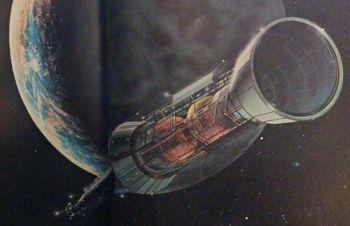U.N.S.S. Icarus (FASA)
On 25 February 2051,[Notes 1] the Columbus class U.N.S.S. Icarus, commanded by Captain Roger Tauber, departed on the first manned expedition to Alpha Centauri, the nearest star system to Earth, to search for a habitable planet. A crowd of several thousand people watched nearby as the ship was launched from the moon, while billions watched live, televised coverage. The estimated travel time for the voyage was six years. On 23 June 2056, the Icarus arrived at Alpha Centauri IV. Contact was established with a humanoid culture there, despite many scientific predictions doubting the possibility of intelligent, humanoid life elsewhere in the universe.[1][2][3]
The Icarus returned to Earth from its historic journey in September 2063,[1] five months after the launch of Zefram Cochrane's Phoenix and first contact with the Vulcans.[4] A United Nations mission was dispatched to Alpha Centauri to begin official recognition, discuss trade, and exchange knowledge of each other's history.[5] The Icarus, following its retirement in 2100, was preserved at the Spaceflight Museum at Earth's moon.[1]
FASA Timeline
On 25 February 2042, the Columbus class U.N.S.S. Icarus, commanded by Captain Roger Tauber, departed on the first manned expedition to Alpha Centauri, the nearest star system to Earth, to search for a habitable planet. A crowd of several thousand people watched nearby as the ship was launched from the moon, while billions watched live, televised coverage. The estimated travel time for the voyage was six years. On 23 June 2048, the Icarus arrived at Alpha Centauri. Contact was established with a humanoid culture there, despite many scientific predictions doubting the possibility of intelligent, humanoid life elsewhere in the universe.[1][2][3]
The Icarus returned to Earth from its historic journey in September 2054. A United Nations mission was dispatched to Alpha Centauri to begin official recognition, discuss trade, and exchange knowledge of each other's history.[5] The Icarus, following its retirement in 2075, was preserved at the Spaceflight Museum at Earth's moon.[1]
Notes
- ↑ While the FASA/Spaceflight Chronology date conversion would ordinarily place the Icarus departure in 2050, this would also place its return to Earth in 2062, a year before First Contact with the Vulcans as depicted in Star Trek: First Contact, which was explicitly stated to be the first publicly known meeting of Humans with extraterrestrials. The dates have been adjusted by one year, placing the ship's return five months after the events of the film.
References
- ↑ 1.0 1.1 1.2 1.3 1.4 Goldstein, Stan and Goldstein, Fred with Sternbach, Rick. Star Trek: Spaceflight Chronology. Pocket Books, 1980.
- ↑ 2.0 2.1 Wheeler, Wm. John with McLimore, Guy W. Jr., Poehlein, Greg K., and Tepool, David F. "Cadet's Orientation Sourcebook." Star Trek: The Role Playing Game, Book 2004A. FASA Corporation, 1983.
- ↑ 3.0 3.1 Theisen, John A.. "The Romulan War." Star Trek: The Role Playing Game, Supplement 2221A. FASA Corporation. 1986.
- ↑ Berman, Rick (Producer). Star Trek: First Contact. Directed by Jonathan Frakes. Story by Rick Berman & Brannon Braga & Ronald D. Moore. Screenplay by Brannon Braga & Ronald D. Moore. Paramount Pictures Corporation, 22 November 1996.
- ↑ 5.0 5.1 Menke, Bernard Edward and Stuart, Rick David. "The Federation." Star Trek: The Role Playing Game, Supplement 2011. FASA Corporation. 1986.
